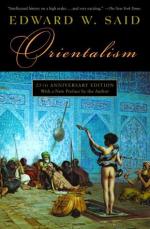|
This section contains 3,903 words (approx. 14 pages at 300 words per page) |

|
ORIENTALISM. Once associated with the exotic "Eastern" themes and styles of Eugene Delacroix's, James McNeill Whistler's, and John Singer Sargent's paintings; Victor Hugo's Les Orientales; and Gustave Flaubert's Salammbô (though related representations also can be found in subjects ranging from world fairs to such Hollywood films as The Thief of Baghdad and Lawrence of Arabia), the term Orientalism has come to denote a broader complex of discursive assumptions and institutional (especially academic) practices that regulate the understanding, appreciation, and domination of the West's—more precisely, Europe's—supposed "Other." In the study of religion, both from confessional dogmatic and secular comparatist perspectives, Orientalism evokes the tendency to mystify, caricature, homogenize, and petrify Asian and North African cultural systems, whether via idealization or via demonization, viewing them as contrasting to and often opposing such "Western" concepts as privatized and rationalized belief or the separation of church and state. Indeed, the...
|
This section contains 3,903 words (approx. 14 pages at 300 words per page) |

|


